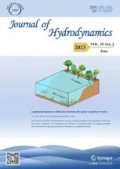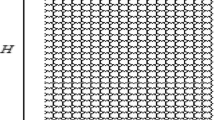Abstract
This paper assesses the ability of smoothed particle hydrodynamics (SPH) to simulate mixing of two-phase flows and their transition to instabilities under different flow regimes. A new measure for quantification of the degree of mixing between phases in a Lagrangian framework is also developed. The method is validated using the lid-driven cavity and two-phase Poiseuille flow cases. The velocity along the centre of the cavity is compared with results from the literature, whilst commercial volume-of-fluid code STAR-CCM+ provides a benchmark for the mixing and different mixing measures are considered. The velocity of two-phase Poiseuille flow along the channel is compared to the analytical solution, and the appearance of interfacial instabilities with perturbation theory. This is the first time SPH has been used to investigate the onset and development of these instabilities. In particular, it is able to model the deforming shape of the interface, which is not given by analytical studies, while also offering improved predictions over conventional mesh-based computational fluid dynamics simulations.
Similar content being viewed by others
References
Chang S., Zhou C., Golchert B. Eulerian approach for multiphase flow simulation in a glass melter [J]. Applied Thermal Engineering, 2005, 25(17–18): 3083–3103.
Kunz R. F., Boger D. A., Stinebring D. R. et al. A preconditioned Navier-Stokes method for two-phase flows with application to cavitation prediction [J]. Computers and Fluids, 2000, 29(8): 849–875
Gingold R. A., Monaghan J. J. Smoothed particle hydrodynamics: theory and application to non-spherical stars [J]. Monthly Notices of the Royal Astronomical Society, 1977, 181(3): 375–389.
Lucy L. B. A numerical approach to the testing of the fission hypothesis [J]. The Astronomical Journal, 1977, 82: 1013–1024.
Hughes J. P., Graham D. I. Comparison of incompressible and weakly-compressible SPH models for free-surface water flows [J]. Journal of Hydraulic Research, 48(Sup1): 2010, 105–117.
Wang Z. B., Chen R., Wang H. et al. An overview of smoothed particle hydrodynamics for simulating multiphase flow [J]. Applied Mathematical Modelling, 2016, 40(23): 9625–9655.
Liu M., Zhang Z. Smoothed particle hydrodynamics (SPH) for modeling fluid-structure interactions [J]. Science China Physics, Mechanics and Astronomy, 2019, 62(8): 984701.
Monaghan J. Implicit SPH drag and dusty gas dynamics [J]. Journal of Computational Physics, 1977, 138(2): 801–820.
Colagrossi A., Landrini M. Numerical simulation of interfacial flows by smoothed particle hydrodynamics [J]. Journal of computational physics, 2003, 191(2): 448–475.
Lind S., Stansby P., Rogers B. D. Incompressible-compressible flows with a transient discontinuous interface using smoothed particle hydrodynamics (SPH) [J]. Journal of Computational Physics, 2016, 309: 129–147.
Hu X. Y., Adams N. A. A multi-phase SPH method for macroscopic and mesoscopic flows [J]. Journal of Computational Physics, 2006, 213(2): 844–861.
Fourtakas G., Rogers B. Modelling multi-phase liquidsediment scour and resuspension induced by rapid flows using smoothed particle hydrodynamics (SPH) accelerated with a graphics processing unit (GPU) [J]. Advances in Water Resources, 2016, 92: 186–199.
Zubeldia E. H., Fourtakas G., Rogers B. D. et al. Multiphase SPH model for simulation of erosion and scouring by means of the shields and Drucker-Prager criteria [J]. Advances in Water Resources, 2018, 117: 98–114.
Manenti S., Sibilla S., Gallati M. et al. SPH simulation of sediment flushing induced by a rapid water flow [J]. Journal of Hydraulic Engineering, ASCE, 2011, 138(3): 272–284.
Kwon J., Monaghan J. J. A novel SPH method for sedimentation in a turbulent fluid [J]. Journal of Computational Physics, 2015, 300: 520–532.
Kwon J., Monaghan J. J. Sedimentation in homogeneous and inhomogeneous fluids using SPH [J]. International Journal of Multiphase Flow, 2015, 72: 155–164.
Xenakis A., Lind S., Stansby P. et al. Landslides and tsunamis predicted by incompressible smoothed particle hydrodynamics (SPH) with application to the 1958 Lituya Bay event and idealized experiment [J]. Proceedings of the Royal Society A, 2017, 473(2199): 20160674.
Pu J. H., Huang Y., Shao S. et al. Three-Gorges Dam fine sediment pollutant transport: Turbulence SPH model simulation of multi-fluid flows [J]. Journal of Applied Fluid Mechanics, 2016, 9(1): 1–10.
Monaghan J., Kocharyan A. SPH simulation of multiphase flow [J]. Computer Physics Communications, 1995, 87(1–2): 225–235.
Szewc K., Pozorski J., Minier J. P. Spurious interface fragmentation in multiphase SPH [J]. International Journal for Numerical Methods in Engineering, 2015, 103(9): 625–649.
Tartakovsky A. M., Ferris K. F., Meakin P. Lagrangian particle model for multiphase flows [J]. Computer Physics Communications, 2009, 180(10): 1874–1881.
Robinson M. Turbulence and viscous mixing using smoothed particle hydrodynamics [D]. Doctoral Thesis, Melbourne, Australia: Monash University, 2009.
Canelas R., Ricardo A., Ferreira R. et al. Hunting for Lagrangian coherent structures: SPH-LES turbulence simulations with wall-adapting local eddy viscosity (WALE) model [C]. Proceedings of the 11th International Smoothed Particle Hydrodynamics European Research Interest Community (SPHERIC) workshop, Munich, Germany, 2016.
Tóth B., Szabó K. Flow structure detection with smoothed particle hydrodynamics [C]. 9th International SPHERIC Workshop, Paris, France, 2014.
Dauch T. F., Ates C., Keller M. C. et al. Analyzing primary breakup in fuel spray nozzles by means of Lagrangian-coherent structures [C]. Proceedings of the 14th SPHERIC International Workshop, Exeter, UK, 2019.
Crespo A. J., Domínguez J. M., Rogers B. D. et al. DualSPHysics: Open-source parallel CFD solver based on smoothed particle hydrodynamics (SPH) [J]. Computer Physics Communications, 2015, 187: 204–216.
Ghia U., Ghia K. N., Shin C. High-Re solutions for incompressible flow using the Navier-Stokes equations and a multigrid method [J]. Journal of Computational Physics, 1982, 48(3): 387–411.
Yih C. S. Instability due to viscosity stratification [J]. Journal of Fluid Mechanics, 1967, 27: 337–352.
Yiantsios S. G., Higgins B. G. Linear stability of plane Poiseuille flow of two superposed fluids [J]. Physics of Fluids, 1988, 31(11): 3225–3238.
Charles M., Lilleleht L. An experimental investigation of stability and interfacial waves in co-current flow of two liquids [J]. Journal of Fluid Mechanics, 1965, 22: 217–224.
Kao T. W., Park C. Experimental investigations of the stability of channel flows. Part 2. Two-layered co-current flow in a rectangular channel [J]. Journal of Fluid Mechanics, 1972, 52: 401–423.
Quinlan N. J., Basa M., Lastiwka M. Truncation error in mesh-free particle methods [J]. International Journal for Numerical Methods in Engineering, 2006, 66(13): 2064–2085.
Pinarbasi A., Liakopoulos A. The effect of variable viscosity on the interfacial stability of two-layer Poiseuille flow [J]. Physics of Fluids, 1995, 7(6): 1318–1324.
Valluri P., Náraigh L. Ó., Ding H. et al. Linear and nonlinear spatio-temporal instability in laminar two-layer flows [J]. Journal of Fluid Mechanics, 2010, 656: 458–480.
Hooper A., Boyd W. Shear-flow instability at the interface between two viscous fluids [J]. Journal of Fluid Mechanics, 1983, 128: 507–528.
Hooper A. P. The stability of two superposed viscous fluids in a channel [J]. Physics of Fluids A: Fluid Dynamics, 1989, 1(7): 1133–1142.
Anturkar N. R., Papanastasiou T. C., Wilkes J. O. Linear stability analysis of multilayer plane Poiseuille flow [J]. Physics of Fluids A: Fluid Dynamics, 1990, 2(4): 530–541.
Gómez-Gesteira M., Rogers B. D., Dalrymple R. A. et al. State-of-the-art of classical SPH for free-surface flows [J]. Journal of Hydraulic Research, 2010, 48(Suppl.1): 6–27.
Monaghan J. J. Simulating free surface flows with SPH [J]. Journal of Computational Physics, 1994, 110(2): 399–406.
Wendland H. Piecewise polynomial, positive definite and compactly supported radial functions of minimal degree [J]. Advances in Computational Mathematics, 1995, 4(1): 389–396.
Dehnen W., Aly H. Improving convergence in smoothed particle hydrodynamics simulations without pairing instability [J]. Monthly Notices of the Royal Astronomical Society, 2012, 425(2): 1068–1082.
Crespo A., Gómez-Gesteira M., Dalrymple R. A. Boundary conditions generated by dynamic particles in SPH methods [J]. Computers, Materials and Continua (CMC), 2007, 5(3): 173–184.
English A., Domínguez J., Vacondio R. et al. Correction for dynamic boundary conditions [C]. 14th SPHERIC International Workshop, Exeter, UK, 2019.
Skillen A., Lind S., Stansby P. K. et al. Incompressible smoothed particle hydrodynamics (SPH) with reduced temporal noise and generalised Fickian smoothing applied to body-water slam and efficient wave-body interaction [J]. Computer Methods in Applied Mechanics and Engineering, 2013, 265: 163–173.
Molteni D., Colagrossi A. A simple procedure to improve the pressure evaluation in hydrodynamic context using the SPH [J]. Computer Physics Communications, 2009, 180(6): 861–872.
Lo E. Y., Shao S. Simulation of near-shore solitary wave mechanics by an incompressible SPH method [J]. Applied Ocean Research, 2002, 24(5): 275–286.
Sun P., Colagrossi A., Marrone S. et al. Detection of Lagrangian coherent structures in the SPH framework [J]. Computer Methods in Applied Mechanics and Engineering, 2016, 305: 849–868.
Lind S. J., Xu R., Stansby P. K. Incompressible smoothed particle hydrodynamics for free-surface flows: A generalised diffusion-based algorithm for stability and validations for impulsive flows and propagating waves [J]. Journal of Computational Physics, 2012, 231(4): 1499–1523.
Rogers B. D. Test 3: 2-D lid-driven cavity flow without gravity-2D SPH validation, http://spheric-sph.org/tests/test-3, 2020.
Bird R. B., Stewart W. E., Lightfoot E. N. Transport phenomena [M]. New York, USA: John Wiley and Sons, 2007.
Rowlatt C. F., Lind S. J. Bubble collapse near a fluid-fluid interface using the spectral element marker particle method with applications in bioengineering [J]. International Journal of Multiphase Flow, 2017, 90: 118–143.
Tang H., Wrobel L. Modelling the interfacial flow of two immiscible liquids in mixing processes [J]. International Journal of Engineering Science, 2005, 43(15–16): 1234–1256.
Yang G. Du B., Fan L. Bubble formation and dynamics in gas-liquid-solid fluidization-A review [J]. Chemical Engineering Science, 2007, 62(1–2): 2–27.
Tang H., Wrobel L., Fan Z. Tracking of immiscible interfaces in multiple-material mixing processes [J]. Computational Materials Science, 2004, 29(1): 103–118.
Acknowledgement
The work was supported by the EPSRC and National Nuclear Laboratory (Grant No. 1961431).
Author information
Authors and Affiliations
Corresponding author
Additional information
Biography: Georgina Reece, Ph. D. Candidate
Rights and permissions
About this article
Cite this article
Reece, G., Rogers, B.D., Lind, S. et al. New instability and mixing simulations using SPH and a novel mixing measure. J Hydrodyn 32, 684–698 (2020). https://doi.org/10.1007/s42241-020-0045-x
Received:
Revised:
Accepted:
Published:
Issue Date:
DOI: https://doi.org/10.1007/s42241-020-0045-x




